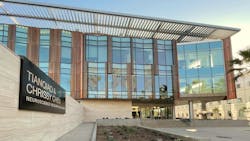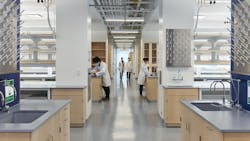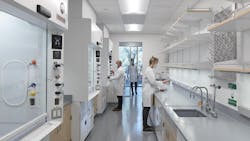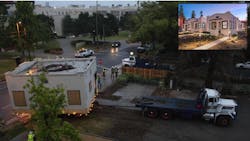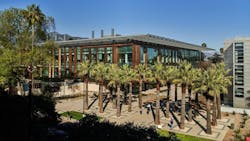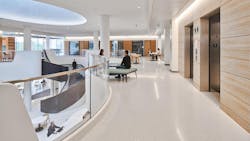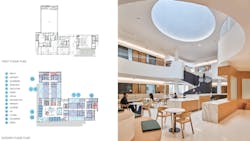Caltech's new neuroscience building unites scientists, engineers to master the human brain
GOLD AWARD
Caltech Tianqiao and Chrissy Chen Neuroscience Research Building
Pasadena, California
Project Information
Project size: 144,780 sf
Project cost: $193 million
Construction time: April 2017 to October 2020
Delivery method: Design-Build
Building Team
Submitting firms: Hensel Phelps (general contractor), SmithGroup (architect)
Owner: California Institute of Technology
Structural engineer: Saiful Bouquet Structural Engineers
MEP engineer: Affiliated Engineers
Judges comments
“LEED on steroids. They had a boatload of money and it was not wasted. The building integrates smoothly into the community and provides a haven for those doing the research. The labs provide the necessary workspace and collaboration to advance science to the benefit of all humanity. This is a building where innovators will be bred to address issues such as COVID.”
“The design and implementation of sustainable strategies within this high-tech project is commendable. The teamwork involved to move existing buildings, create multiple levels of connectivity with adjacent buildings, and preserve the landscape is worth rewarding.”
“Excellent mission toward the future of neuroscience. Special note about the attention to the community with relocating the bungalows.”
Essay by submitting firms
The project had its origins in 2015, when a BBC television story about Caltech neuroscientist Richard Andersen caught the attention of philanthropists Tianqiao Chen and Chrissy Luo. After seeing how Richard Andersen’s brain-machine interface helped a patient with quadriplegia use thought to control a robotic arm, they traveled from their home in Singapore to Pasadena, California, to meet Andersen in person at Caltech (Xia, 2016). It was here, on campus, that they embarked on a journey to bring together the world’s most talented neuroscience researchers.
With a goal to improve the human experience by understanding how our brains perceive, learn, and interact with the world, Chen and Luo committed an initial $1 billion to establish the Tianqiao and Chrissy Chen Institute (TCCI) in late 2016. The institute forms cornerstone partnerships with leading institutions around the world in order to accelerate fundamental brain research through endowments, custom programs, and moonshot research. The institute’s first award went to Caltech, as Chen and Luo partnered with Caltech to launch the Tianqiao and Chrissy Chen Institute for Neuroscience at Caltech. Spearheaded with a $115 million gift from Chen and Luo to Caltech, the Chen Institute for Neuroscience unites investigators across campus to create a unique environment for brain research. The goal is to deepen our understanding of the brain—the most powerful biological and chemical computing machine.
As part of the Chen Institute for Neuroscience, Caltech broke ground on the new 150,000-square-foot, $193 million Tianqiao and Chrissy Chen Neuroscience Research Building (CNRB) in December 2017. The facility centralizes Caltech’s diverse brain research efforts in one campus location.
“Everyone at Caltech is doing amazing work—we are constantly impressed and proud of the steady drumbeat of research coming out of Caltech. We love how the building is going to help facilitate this work.” – Chrissy Luo, TCCI Cofounder, 2021
Caltech, Chen, and Luo share a central goal for the new building: to illuminate the complex infrastructure and inner workings of the human brain, from its basic functions to how it fails because of disease or through the aging process. To accomplish this goal, the new facility fosters interdisciplinary research and enhanced collaboration by uniting and assembling multiple user groups, including neuroscientists, biologists, chemists, physicists, engineers, computer scientists, and social scientists across all six of Caltech’s academic divisions, as well as principal investigators and research groups from around the globe.
Project Goals and Objectives
Caltech outlined its goals and objectives for a new research building: to design and build a world-class research facility that would be customizable for scientists from many different disciplines and bring together brain-related research programs from across the campus. More specifically, the Division of Biology and Biological Engineering (BBE) had a vision to create new centers or “research neighborhoods” to support focus areas spanning bioengineering, medical engineering, translational medicine, and neuroscience. The new research center would need to provide advanced tools and techniques aimed at building upon Caltech’s long tradition of discovery in molecular, cellular, and systems neuroscience. A secondary goal of the proposed new building was to provide a new administrative home for BBE.
In sum, the building would consolidate biology programs that previously were spread across the campus in one state-of-the-art facility. It would offer shared lab spaces and centralized hubs where the campus-wide community of neuroscientists, biologists, chemists, physicists, engineers, computer scientists, and social scientists could come together to continue and catalyze their groundbreaking work. At the center of the building, there would be an area called the “nucleus” that symbolizes the power of collaboration. The nucleus would visually connect people and spaces in order to inspire and reflect the moments when ideas come together, sometimes resulting in scientific breakthroughs.
Full height low-e glazing delivers natural light throughout the interior spaces. Photographers: John Linden/John Edward Linden Photography; Ian Allen/Esto
All of these attributes provide Caltech the means to deliver a facility that promises to dramatically improves the division’s operational efficiency and give faculty, students, staff, and visitors an overall environmental experience that is highly functional, inviting, comfortable, and inspiring. Guided by the overarching goals and objectives outlined by the team, BBE’s research enterprise stands to benefit immensely from the addition of the CNRB through increased productivity and cross-disciplinary collaboration that stimulates innovation in research aimed at illuminating the fundamental principles of how the brain works.
Design Excellence
Inspired by biology and neuroscience, the Hensel Phelps | SmithGroup design-build team worked through many iterations of laboratory design concepts with Caltech and decided upon a model we call “transparent” lab design. It places open laboratories back-to-back, allowing light all the way through from one side of the building to the other. The flexible, fully customizable labs are connected to a central collaboration hub (the “nucleus”) to encourage serendipitous interactions, the informal exchange of ideas, and cross-disciplinary collaboration among research groups.
As a demonstration of Caltech’s commitment to transparency, the facility features a stunning glass window façade that illuminates the interior with bright, natural daylight. Biophilic design is showcased through a sunken garden adjacent to the building that promotes a sense of serenity and inspires creativity. The building borders Moore Walk, a primary pedestrian pathway, and features one of the largest campus-wide auditorium and seminar spaces, reservable conference spaces with plug-and-play technology, wet and dry laboratories, and a variety of suites for behavioral studies. Captivating artwork displayed throughout the building depicts the human brain, inspired by Santiago Ramon y Cajal, a Spanish neuroscientist and pathologist.
Sustainable Design
Caltech’s commitment to sustainable design centers on energy use reduction, water use reduction, and carbon footprint reduction. In line with this commitment, Caltech is seeking LEED Gold certification for the CNRB. As part of the sustainable design, the Hensel Phelps | SmithGroup design-build team included façade/glazing optimization, reduced air change rates, active chilled beams, high-efficiency ultra-low temperature freezers (purchased as part of the construction budget to ensure implementation), low-flow plumbing fixtures, and water reuse from cooling coils. Because many of these technologies were either newly represented or newly applied to an intensive research building, navigating risks and technical issues was a part of the integrated design process. As a research- and energy-intensive building, the CNRB will consume approximately 295 kBtu/sf/year. This compares favorably to the Caltech average for research buildings of 411 kBtu/sf/year.
Inventive Use of Materials
This project not only had superior standards to meet, but also utilized some exceptional building materials. For example, the exterior façade is a combination of glazing, copper, and travertine that was fabricated in Italy by Mariotti—a fourth-generation, family-owned quarry that has been in operation for over 800 years. The travertine stone required team members to travel to Italy. They visited the quarry to approve of each stone prior to shipment. A dry layout was then reviewed via video technology for quality assurance. On its way to the Caltech site, the delivery truck was involved in an unfortunate accident that caused damage to several of the stone pieces. With great effort, the team was able to salvage the remaining material to fit the façade with very little delay.
Just as the interior layout aims to cultivate the cutting-edge sensibilities of Caltech, SmithGroup’s architectural design achieves this through its material palette and dynamic skin expression. Invoking the imagery of the forest, the second and third floors emphasize its verticality with a curtain wall that changes in scale from lab to office. The play of vertical panels is further emphasized by strips of copper panel accents within the curtain wall, moving toward a more solid expression at the end of each wing. This contrast between solidity and transparency is driven partly by programmatic needs but also gives a sense of boundary to the building. To contrast the lightness and transparency of the upper floors, the base of the building, where it interacts with the landscape, is predominantly travertine.
Wayfinding, Site Planning, and User Access
The building consists of three stories above grade and two stories below grade, helping to maintain Caltech’s open, low-density academic setting. To preserve open views through campus as required by the Caltech master plan, the main body of the building is elevated, with a break in the ground-level mass to allow greater visual connection. This “breezeway” creates a shaded, comfortable place that is open to the campus and carefully aligned with existing campus pathways. The ground floor is also integrated into the surrounding landscape through an outdoor event/garden space and a bridge on the north side of the building that can be used for BBE functions.
The main body of the building uses a classic top canopy structure while also evoking contemporary features through the treatment of the façade materials. A lobby space, multifunction seminar room, and 150-seat auditorium are strategically placed on the ground floor for use by the greater campus.
Engineering Excellence
Highly specialized laboratory spaces are essential to accommodate the research taking place at Caltech, and specifically within the CNRB. In turn, robust mechanical and electrical systems are necessary to support varying lab layouts and equipment. Traditional lab design generally avoids customization and prefers repeatability from lab to lab. Thus, the expectations of customized labs for the CNRB affected cost and presented a more demanding schedule.
“All of the exploration taking place at the facility is unique—the labs are a direct reflection of the remarkable and highly individual research.” – Terri Mestas, Senior Director of Design and Construction, Caltech, 2021
To minimize the impacts of construction on cost and schedule, the design-build team created as much commonality as possible in the system architectural layout and in engineering capacities, qualities, and layouts. This commonality provided sufficient flexibility to accommodate the natural progression of feedback from principal investigators while helping the team stay on track despite many revisions and changes.
Our MEP engineer, Affiliated Engineers (AEI), also developed a three-source reliability solution for the building to ensure that critical research at the CNRB can continue uninterrupted. The three sources include the following:
- Bloom fuel cells, which have been used on the Caltech campus for 11 years without failure, are assigned as the primary power source. Fuel cells are not only reliable, but also sustainable, since they convert natural gas fuel into clean electricity through an electrochemical reaction instead of combustion. This process virtually eliminates criteria air pollutants, including NOx and SOx, which are emitted by conventional power plants.
- Should the unexpected occur and the Bloom fuel cells fail, the power source would automatically transfer to Pasadena Water and Power (PWP), a reliable local utility that provides electricity to the balance of the Caltech campus.
- Should both the fuel cells and PWP go offline, a diesel-powered emergency generator with 16 hours of fuel would automatically start up to meet critical power needs within the CNRB.
This solution provides the CNRB with the greatest level of electrical reliability and resiliency on the Caltech campus.
The structural system also entailed some unique challenges. As a hybrid concrete and steel system, it allowed an early start for construction of the foundations. Below-grade construction could start early, while the steel for the superstructure was being fabricated. The design necessitated 14’ cantilevers, and the engineering of a steel system accommodated the restrictive vibration criteria.
In addition to designing the structure to meet the prescriptive requirements of the building code, a separate, parallel, highly sophisticated, and advanced seismic non-linear earthquake time-history analysis was performed to confirm the building’s seismic performance in the event of maximum credible regional earthquakes.
Construction Excellence
Thanks to our established relationship with the Southern California subcontracting community, Hensel Phelps secured a first-in-class and highly qualified labor force to ensure that the state-of-the-art CNRB project would be successful. Selection of the hand-picked teammates and trade partners was based on previous experiences, trust, and established lines of communication. From the first day, during the RFP team interview, our team demonstrated to Caltech that quality, production, safety, and completion dates were the focus.
A few areas on Caltech’s campus that required careful preservation. These included the following:
- Bungalow court: In recognition of Pasadena’s architectural heritage, Caltech elected to preserve seven bungalows originally located at the southeast corner of Wilson Avenue and Del Mar Boulevard on the Caltech campus, where the CNRB was to be located. Through conversations with the City of Pasadena, Caltech worked with a historic preservation company alongside Hensel Phelps to preserve these historic bungalows and transport them to a new location two blocks away. The bungalows have since been renovated, keeping their original formation and layout completely intact, and now serve as Caltech faculty housing.
- Oak tree: Just as important as the bungalow court was a giant oak tree located in the middle of the construction site. Instead of tearing it out and making waste of the tree, the Hensel Phelps | SmithGroup design-build team made use of this amazing tree by finding a place for it. The team created a statement by relocating the oak tree at the southeast corner of Wilson Avenue and Del Mar Boulevard.
- Surrounding trees: Throughout the construction process, Hensel Phelps wanted to ensure respect for the environmental importance of the trees surrounding Caltech. The Institute is open to the community and is an integral part of the city of Pasadena. Thus, the trees were a protected feature of the community and, therefore, of Caltech. To preserve the trees, Hensel Phelps went the extra mile to fence off trees surrounding the construction site.
The Hensel Phelps team also self-performed the concrete on the project, placing over 10,000 cubic yards. This process allowed the team to better control the quality and schedule of the project. The internal quality-control process ensured that all rebar support and openings were properly coordinated and installed, while also maintaining proper staffing levels to support the overall construction schedule.
Another part of the project scope that required construction excellence included a pedestrian tunnel to be built between the CNRB and the Broad Center for Biological Sciences. To minimize the duration and associated disruption, planning for the tunnel began 15 months in advance. In the end, the tunnel was constructed using 10 pre-cast tunnel sections. Each pre-cast section was 12’x12’x10’ long and weighed approximately 40 tons. To minimize the site impact, tunnel construction occurred during a national neuroscience convention when staff were out of town. The successful planning and execution of the tunnel not only created much-needed open space on the job site, but also helped establish greater credibility for the team.
Innovative Technology
The Hensel Phelps | SmithGroup design-build team used Building Information Modeling (BIM) technology throughout all stages of design and construction. During the proposal stage, we included 3-D renderings depicting our design, along with 3-D images of site logistics and construction activities. During pre-construction, BIM was used to help coordinate MEP scopes and identify potential clashes in the field. The field staff used BIM to help coordinate the structural concrete for proper planning and estimation of placement pours. During the construction phase, BIM was used to help with site utilization and material-handling plans. The team also used BIM to manage the install of major concrete components, along with MEPF scope that was detailed using 3-D software.
Our design-build team ultimately met the needs of Caltech by providing a well-coordinated and detailed model they could use for their facilities team, along with record documents should changes be needed over the course of the building’s lifespan. Additionally, the project team used Virtual Reality (VR) technology to build out virtual mock-ups for a typical principal investigator office layout as well as lab, staff, and public spaces. This enabled the project team to secure early buy-in from the key stakeholders of the project. We also utilized VR goggles early in the design process to help Caltech representatives and members of the Board of Trustees imagine the spaces and, ultimately, expedite the approval process.
Construction Safety
Working on an active campus took constant planning to ensure the safety of the project team, students, faculty, and the public. The slogan used for the project was “Safe and Separate,” meaning that the project team needed to keep all parties safe and separate from construction operations. Weekly site logistics meetings were held to review upcoming work and coordinate deliveries and work taking place outside of our project fence on the campus. The team also held daily huddles with all stakeholders to discuss each day’s current risks.
As noted above, one of the most extensive safety risks for the project was the relocation of the historical bungalows. Hensel Phelps went through months of extensive planning with Caltech and the City of Pasadena to ensure that the relocation of the bungalows did not impact campus neighbors. Relocation of the seven bungalow buildings began at midnight and finished ahead of the scheduled 7:00 a.m. deadline to re-open the road. Eleven units in seven buildings were completely renovated inside and out, from termite-infested wood framing to the historic exterior plaster. The relocation of the bungalows was a perfect safety success.
BUILDING TEAM COLLABORATION
The Hensel Phelps | SmithGroup design-build team was selected for the CNRB because of our extensive design-build portfolio and proven success developing highly technical and complex solutions. Since the notice of award, every decision made throughout this project was the result of a collaborative, consensus-driven team effort and a high level of stakeholder engagement. This approach—combined with innovative engineering solutions and design ingenuity—was utilized and embraced throughout the entire design-build process. The camaraderie among all team members was evident in weekly meetings on execution, staffing, schedule, and budget. Ample interfacing regarding materials, layout, and engineered systems occurred regularly between Caltech’s facility and operations management teams and the design team.
Cost/Budget Resolution
The Hensel Phelps | SmithGroup design-build team was able to design to budget throughout the design phase due to a high level of communication, collaboration, and investigation. When Caltech requested changes, the project team provided timely cost estimates and reviews that gave Caltech enough time to understand the changes and make efficient and accurate decisions. The Hensel Phelps team provided cost estimates, constructability reviews, site investigations, schedules, and coordination with all stakeholders—with a proactive spirit that has proven successful on all Hensel Phelps projects. Hensel Phelps’ approach to preconstruction and construction phases for the CNRB was to manage the flow of relevant information in order to receive timely information into the right hands at the right time.
Design deliverables were used to coordinate and schedule buyout, permit review, etc., and to target budgets based on significant owner input for more than 50 definable project features and systems. The Hensel Phelps | SmithGroup design-build team was successful in meeting the budget, schedule, and major milestones through the following design-to- budget methods and procedures:
- Engaged with Caltech and design team early and often
- Performed real-time estimate trending
- Held focus groups for quality and to monitor the smaller pockets of money (helped keep focus on the overall budget)
- Used a senior estimator for trending analysis
- Performed cost neutralization and balance
- Understood design team's wishes with real-time cost and schedule data
- Budgeted concurrently with the design rather than reacting to design changes
To meet the project’s goal of designing and building a world-class, customizable neuroscience research facility, it was appropriate and necessary to maintain a very high level of engagement throughout the design-build-construction process. From the onset of design, stakeholders and principal investigators regularly attended meetings to help develop and document their vision. Given the technical use of the space, it was essential to have stakeholder and user input every step of the way. For example, lab space mock-ups were completed early on so the owner and principal investigators could physically see, touch, and move around in their spaces. This allowed researchers to coordinate, collaborate, and document feedback to ensure that the end design would fit their needs and preferences. The design-build team sent out weekly updates on progress as well as upcoming activities. This engagement continued in the form of tours for the principal investigators, department heads, and facilities groups so that they could see the development of the construction up close.
“Everyone has been a delight to work with and very accommodating. We also deeply appreciate the expert knowledge of the building’s various features that each of you shared with us.” – Rachel Cartmell, Executive Director of Advancement Communications and Events, Caltech, 2021
Community Involvement/Social & Cultural Relevance
Beyond client and stakeholder interactions, the building team engaged the local community by presenting an initial project overview to the City of Pasadena. Community members residing in the areas immediately surrounding campus demonstrated significant support of the overarching project vision and were provided opportunities to remain involved through recurring neighborhood meetings. These meetings included building occupants as well as neighbors and allowed community members to stay informed about project status, schedules, and special events, such as graduation weekend. This purposeful communication and proactive planning around neighbors’ needs helped build rapport and confidence in Caltech’s impact as a positive force in the community.
Overcoming COVID-19 Issues
The novel coronavirus (COVID-19) pandemic was the largest and most unexpected project challenge. Because the Centers for Disease Control and Prevention (CDC) considered construction an essential service, the project team was able to maintain operations despite other job sites being shut down. Even so, COVID-19 forced the building team to rapidly develop new guidelines and procedures to find pinch points and commitments, milestones, and enhanced safety protocols. Guidelines set forth by city and state government authorities and the implementation of strict social distancing requirements further challenged the overall project, prolonging the schedule and pushing activities closer to the end date.
Despite these unforeseen obstacles, success and on-time completion were achieved through several interwoven factors, including the tightly knit group of leaders, the overall synergy of the team, and collaboration with Caltech to make the necessary site changes for safety compliance. Hensel Phelps was proactive in providing personal protective equipment (PPE) for all building team members, as well as restructuring the job site to reflect segregated work/break areas and additional access points to ensure social distancing. An on-site cleaning crew was also enlisted to clean stairwells, handrails, elevator buttons, and other common areas in the building on an hourly basis.
To minimize the number of people in areas under construction, video updates from the site were provided to the owner once a week. To ensure safety, building walk-throughs were scheduled after construction workers had left for the day. Project leadership convened weekly COVID-19 status meetings to review requirements from pertinent government authorities, such as enabling contact tracing and keeping the team informed of updates.

